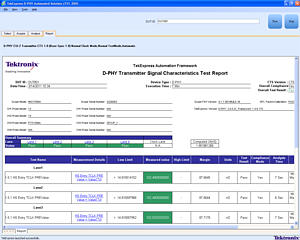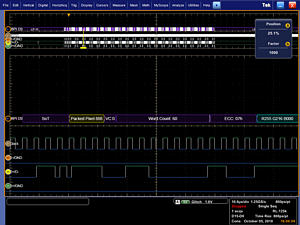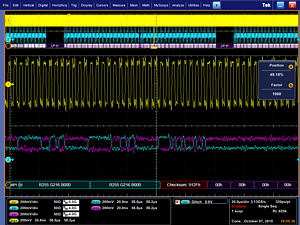
與我們聯絡
與 Tek 業務代表即時對談。 上班時間:上午 6:00 - 下午 4:30 (太平洋時間)
致電
請致電
與 Tek 業務代表即時對談。 上班時間:上午 8:30 - 下午 5:30 (太平洋時間)
下載
下載手冊、產品規格表、軟體等等:
意見回饋
D-PHY Conformance, Characterization, and Decode Datasheet
D-PHYTX, D-PHY, and SR-DPHY
Features & Benefits
Fully-Automated Testing
- Performs Single-button Fully Automated Transmitter Testing seamlessly across High Speed (HS), Low Power (LP) and Ultra-Low Power State (ULPS) sequences in the D-PHY signal
- Does Not Require Operator Intervention to Conduct Time-consuming Testing
- Reduces the Amount of Time Required to Conduct Testing
- Enables Customers to Test Devices Faster
- Allows Selecting Individual Tests or Group-wise Tests through Tree Structure
100% Test Coverage
- Performs all 55 Fully-Automated Tests, including Bus Turnaround (BTA) and Ultra-Low Power State (ULPS) measurements, to the Latest Conformance Test Specification (CTS), and the Latest Base Specification V1.1.
- Benefit from testing for upto 1.5 Gbps datarate D-PHY designs
- Benefit from the Complete Test Coverage of all CTS Tests
- Benefit from Testing to the Latest CTS Revision 1.0
Setup Customization
- Modify the Test Setup as per the DUT Configuration
- Unit Intervals are Automatically Calculated based on the DUT Data Rates
Flexible Probing
- Probe the Design Under Test (DUT) using either Differential, or Single-ended Probes
DSI-1 and CSI-2 Decode Testing
- Decodes DSI-1 and CSI-2 Buses
- Decodes Low-power and High-speed States
- Decodes both Short Packets and Long Packets as well as Other Communications Types such as Bus Turn Around (BTA), Escape Mode Commands, and Low-power Data
- Decodes the DCS Command
Event Table, Search, and Error Indicators
- Decodes along with Timestamps for each Event
- Decodes ECC, Checksum, Data Type, Packet Data, etc.
- Indicates Missing Sync, ECC, and Checksum Errors
- Performs Search through Long Acquisitions
Fully Automated Multilane DUT Testing
- Quickly Validate Multilane DUTs using an External RF Switch Additionally
- Automatically Selects One Lane at a Time for Testing
- Does Not Require Operator Intervention to Switch to Subsequent Lanes for Testing
- Save Time and Resources when Testing Multilanes
Characterization/Margin Testing
- Allows Custom Limits or Limit Editing to Perform Margin Testing
- Performs Characterization of Your Design
Fully Automated Temperature Chamber Testing
- Validate Your Mobile Designs in Extreme Test Conditions using XL Cables, High-temperature Tips, and Standard Filter Files, for all High-speed Tests
- Reduces the Amount of Time required to Conduct Testing in Temperature Oven
Detailed Test Reports
- Provides Pass/Fail Summary Table for Each Lane
- Provides Margin Details on Each Test
- Provides “Zoom-in” Screenshots of the Testing Regions for Each Test
- Provides “Single Printable” Consolidated Report for All Tests and All Lanes
- Provides “Single Printable” Consolidated Report for All Tests
Clock Continuous Mode and Escape Mode
- Perform All Tests in Normal Mode or Selective Tests in Clock Continuous Mode
- Perform both Escape Mode (ULPS) and the Normal Mode Tests
Reliable Results
- Achieve Accurate and Reliable Results from a Single Run
Offline/Remote Analysis
- Perform Measurements using either Live or Pre-acquired Waveform Sets
- Allows Remote Execution of Tests
Error Handling
- Identify Setup/Acquisition Issues Quickly through Applicable Error IDs and Exception Information in Test Reports
Applications
D-PHY Transmitter Testing for:
- D-PHY Interface Design
- DSI-1 or CSI-2 Verification
- System Validation and Integration
- Manufacturing Test

Single-button Fully Automated D-PHY Testing
The Tektronix TekExpress® (TEKEXP) Automated Test software is a Windows-based application that runs on any Windows XP*1 computer operating system including Tektronix Windows-based instruments. TekExpress software ordered with Option D-PHYTX provides an automated, simple, and efficient way to test D-PHY Transmitter interfaces and devices consistent to the requirements of the D-PHY Conformance Test Specification Revision 1.0.
Automated Testing –Save Time and Resources
There is no longer a need to be an expert on testing procedures. Remembering the exact steps to take each measurement is time consuming and often requires going back to the D-PHY specifications. D-PHYTX takes the guesswork out of conducting D-PHY Transmitter testing. Even if you remember how to use the test equipment, it is common for even the most experienced operators to forget steps in the procedure or to set up the correct parameters, like applying the correct trigger technique. D-PHYTX allows engineers to simply select the desired tests to run, multiple lanes to be tested, and then work on other tasks while the tests are being executed.
Simple Setup, Test Execution, and Reporting
Setup and test execution is simple with the TekExpress software. The oscilloscope is controlled through the TekExpress automation framework. The TekExpress software provides a Graphical User Interface (GUI) and provides an intuitive workflow through setup and testing.
Setting Up the Bench
When setting up a test, nothing can be simpler than hooking up the test system by looking at a schematic. View the schematic of the selected test with a push of a button.
Instrument Bench Discovery
TekExpress software automatically (or on demand) scans and detects supported instruments connected in your test bench (both Visa supported and non-Visa supported instruments), whether they are connected through LAN, GPIB, or USB. A quick check of the Instrument Bench menu confirms all instruments are networked correctly.
Pass/Fail Report
The Report tab provides a view of test results along with Pass/Fail status, test margin, and images supporting the test results for each lane of the DUT.
Powered by NI TestStand™
The TekExpress automated compliance software uses NI (National Instruments) TestStand to manage and execute its test sequences. A Windows user interface is provided in the TekExpress software for simple and complete operation of compliance measurements. However, if your validation and debug needs go beyond the features offered by the TekExpress software, a full version of NI TestStand can be used to develop higher-level automation sequence to control the TekExpress software.
NI TestStand is the de facto industry-standard test management environment for automating test and validation systems. NI TestStand is used to develop, manage, and execute test sequences, to integrate test modules written in any test programming language through an open and flexible architecture. Customers who own NI TestStand and purchase the TekExpress software will be able to write scripts using NI TestStand that call the TekExpress software with a limited command set. The limited command set allows the NI TestStand user to recall and save TekExpress software setups, start execution, query current execution status, and receive measurement results.
For device validation, it’s often desirable to make multiple runs of a single device using different operating conditions such as temperature and power supply voltages. This is sometimes referred to as ‘four-corners testing’, (testing to low-high temperature and low-high supply voltages). For four-corners testing, NI TestStand supports drivers for a wide range of temperature chambers and power supplies. NI TestStand can be used to control the temperature chamber and then call the TekExpress software for a compliance test using the limited command set. For adjusting power supply voltages, the power supply control sequence file within the TekExpress software can be modified using a standard NI TestStand sequence file. So if your company already uses NI TestStand for automation, your test engineers can incorporate commands to run the TekExpress compliance software directly into their test sequences.
*1 See host system requirements in the Ordering Information section.
Characteristics
|
Characteristic |
Description |
|---|---|
|
D-PHY Base Specification |
Revision 1.0 and 1.1 |
|
D-PHY Conformance Specification |
Revision 1.0 |
|
Measurements |
Both High-speed and Low-power modes, including ULPS and BTA. |
|
Group 1 |
Data Lane LP-TX Signaling |
|
1.1.1 |
Data Lane LP-TX Thevenin Output High Level Voltage (VOH) |
|
1.1.2 |
Data Lane LP-TX Thevenin Output Low Level Voltage (VOL) |
|
1.1.3 |
Data Lane Rise Time |
|
1.1.4 |
Data Lane Fall Time |
|
1.1.5 |
Data Lane LP-TX Slew Rate vs. CLOAD (δV/δtSR) |
|
1.1.6 |
Data Lane LP-TX Pulse Width of Exclusive-OR Clock (TLP-PULSE-TX) |
|
1.1.7 |
Data Lane LP-TX Period of Exclusive-OR Clock (TLP-PER-TX) |
|
Group 2 |
Clock Lane LP-TX Signaling |
|
1.2.1 |
Clock Lane LP-TX Thevenin Output High Level Voltage (VOH) |
|
1.2.2 |
Clock Lane LP-TX Thevenin Output Low Level Voltage (VOL) |
|
1.2.3 |
Clock Lane Rise Time |
|
1.2.4 |
Clock Lane Fall Time |
|
1.2.5 |
Clock Lane LP-TX Slew Rate vs. CLOAD (δV/δtSR) |
|
Group 3 |
Data Lane HS-TX Signaling |
|
1.3.1 |
Data Lane HS Entry: Data Lane TLPX Value |
|
1.3.2 |
Data Lane HS Entry: THS-PREPARE Value |
|
1.3.3 |
Data Lane HS Entry: THS-PREPARE + THS-ZERO Value |
|
1.3.4 |
Data Lane HS-TX Differential Voltages (VOD(0), VOD(1)) |
|
1.3.5 |
Data Lane HS-TX Differential Voltage Mismatch (ΔVOD) |
|
1.3.6 |
Data Lane HS-TX Single Ended Output High Voltages (VOHHS(DP),VOHHS(DN)) |
|
1.3.7 |
Data Lane HS-TX Common-Mode Voltages (VCMTX(1),VCMTX(0)) |
|
1.3.8 |
Data Lane HS-TX Common-Mode Voltage Mismatch (ΔVCMTX(1,0)) |
|
1.3.9 |
Data Lane HS-TX Dynamic Common-Level Variations Between 50-450 MHz (ΔVCMTX(LF)) |
|
1.3.10 |
Data Lane HS-TX Dynamic Common-Level Variations Above 450 MHz (ΔVCMTX(HF)) |
|
1.3.11 |
Data Lane HS-TX 20%-80% Rise time (tR) |
|
1.3.12 |
Data Lane HS-TX 80%-20% Fall time (tR) |
|
1.3.13 |
Data Lane HS Exit: THS-TRAIL Value |
|
1.3.14 |
Data Lane HS Exit: 30%-80% Post-EoT Rise Time (TREOT) Value |
|
1.3.15 |
Data Lane HS Exit: TEOT Value |
|
1.3.16 |
Data Lane HS Exit: THS-EXIT Value |
|
Group 4 |
Clock Lane HS-TX Signaling |
|
1.4.1 |
Clock Lane HS Entry: TLPX Value |
|
1.4.2 |
Clock Lane HS Entry: TCLK-PREPARE Value |
|
1.4.3 |
Clock Lane HS Entry: TCLK-PREPARE + TZERO Value |
|
1.4.4 |
Clock Lane HS-TX Differential Voltages (VOD(0), VOD(1)) |
|
1.4.5 |
Clock Lane HS-TX Differential Voltage Mismatch (ΔVOD) |
|
1.4.6 |
Clock Lane HS-TX Single Ended Output High Voltages (VOHHS(DP),VOHHS(DN)) |
|
1.4.7 |
Clock Lane HS-TX Common-Mode Voltages (VCMTX(1),VCMTX(0)) |
|
1.4.8 |
Clock Lane HS-TX Common-Mode Voltage Mismatch (ΔVCMTX(1,0)) |
|
1.4.9 |
Clock Lane HS-TX Dynamic Common-Level Variations Between 50-450 MHz (ΔVCMTX(LF)) |
|
1.4.10 |
Clock Lane HS-TX Dynamic Common-Level Variations Above 450 MHz (ΔVCMTX(HF)) |
|
1.4.11 |
Clock Lane HS-TX 20%-80% Rise time (tR) |
|
1.4.12 |
Clock Lane HS-TX 80%-20% Fall time (tR) |
|
1.4.13 |
Clock Lane HS Exit: TCLK-TRAIL Value |
|
1.4.14 |
Clock Lane HS Exit: 30%-80% Post-EoT Rise Time (TREOT) Value |
|
1.4.15 |
Clock Lane HS Exit: TEOT Value |
|
1.4.16 |
Clock Lane HS Exit: THS-EXIT Value |
|
1.4.17 |
Clock Lane HS Clock Instantaneous (UIINST) |
|
Group 5 |
HS-TX Clock-to-Data Lane Timing |
|
1.5.1 |
HS Entry TCLK-PREValue |
|
1.5.2 |
HS Exit TCLK-POST Value |
|
1.5.3 |
HS Clock Rising Edge Alignment to First Payload Bit |
|
1.5.4 |
Data-to-Clock Skew (TSKEW (TX)) |
|
Group 6 |
|
|
1.6.1 |
INIT: LP-TX Initialization Period (TINIT,MASTER) |
|
1.6.2 |
ULPS Entry: Verification of Clock Lane LP-TX ULPS support |
|
1.6.3 |
ULPS Exit: Transmitted TWAKEUP Interval |
|
1.6.4 |
BTA: TX-Side TTA-GO Interval Value |
|
1.6.5 |
BTA: RX-Side TTA-SURE Interval Value |
|
1.6.6 |
BTA: RX-Side TTA-GET Interval Value |
|
Probing Configuration |
Single-ended and differential acquisition |
|
Triggering |
Edge trigger for Clock Lane tests in Clock Continuous Mode. Choice of Width trigger and Transition trigger for all other tests and all other modes |
|
Reports |
Excel xls, html and MHT formats with zoom-in screen shots of the testing regions for each test |
D-PHY Transmitter Testing with D-PHY Essentials or D-PHYTX Automated Solution Software
TekExpress Software with Option D-PHYTX provides single-button full automation of the Tektronix D-PHY Transmitter measurements. DPOJET software with Option D-PHY provides the essential set of D-PHY Transmitter measurements with greater flexibility in the test setup. The following table outlines the key benefits from the DPOJET Option D-PHY and the TekExpress Option D-PHYTX software solutions.
Key Benefits from D-PHY Essentials and D-PHYTX Automated Solution
|
Feature |
Option D-PHY (D-PHY Essentials) |
Option D-PHYTX (D-PHYTX Automated Solution) |
|---|---|---|
|
Prerequisite Tools |
DPOJET Timing and Analysis |
TEKEXP Automation |
|
Automatic Measurement Selections based on Device ID, Test Group, and Selected Probes |
|
X |
|
Single-button Execution for All Measurements |
|
X |
|
Configurable Setup and Editing of Test Limits |
X |
X |
|
Detailed or Summary Reports |
Detailed Only |
Detailed and Summary |
|
Automatically Save Test Reports and Waveforms |
|
X |
|
Re-analyze Prerecorded Waveforms |
X |
X |
|
D-PHY Specific User Interface |
|
X |
|
Base Specification Revision |
V1.0 |
V1.0 and V1.1 (i.e 1.5 Gbps datarate) |
|
Conformance Test Specification Revision |
V1.0 |
V1.0 |
Scope-based Decode for DSI-1 and CSI-2

MSO70000C digital-channel decoded display of a Packed Pixel Stream, 24-bit RGB 8-8-8 format long packet.

MSO70000C analog-channel decoded display of a Packed Pixel Stream, showing a checksum error.
The SR-DPHY application option enables decoding of DSI-1 and CSI-2 buses. SR-DPHY displays all the decoded components of both short packets and long packets as well as other communications types such as Bus Turn Around (BTA) and Escape Mode commands. In addition, DCS packets decode the DCS command.
Low-power States:
- High Speed (LPS HS)
- Escape (LPS Escape)
- Bus Turn Around (LPS BTS)
High Speed:
- Start of Transmission (SoT)
- Short Packets (SP)
- Long Packets (LgP)
- End of Transmission (EoT)
Escape:
- Escape Command (Low-power Data, Ultra-low Power, Reset Trigger, Tearing Effect, and Acknowledge)
- Low-power Data – Will decode as packet data (SP/LgP)
Short Packets:
- Data Type
- Virtual Channel
- Packet Data Byte 1
- Packet Data Byte 2
- Error Correcting Code
Long Packets:
- Data Type
- Virtual Channel
- Word Count
- Error Correcting Code
- Payload (either decoded as pixels or bytes depending upon data type)
- Error Correcting Code
In addition to decoding DSI-1/CSI-2 acquisitions, SR-DPHY also searches through long acquisitions to find all occurrences of the following types of packet content:
- Short Packets (specify VC, DT, Direction, and Packet Data values)
- Long Packets (specify VC, DT, Direction, WC, and Data Payload including pixel values)
- Stop
- Start of Transmission (SoT)
- End of Transmission (EoT)
- Bus Turnaround (DSI-1 only)
- Escape Mode
- ECC Warning
- ECC Error
- Checksum Error
Required Equipment for D-PHY Transmitter Testing
For a complete list of required equipment please visit /MIPI.
Ordering Information
D-PHYTX Automated
|
Model |
Description |
|---|---|
|
DPO7254/C DPO7354/C MSO70000/C DPO/DSA70000B/C/D |
DPO (Digital Phosphor Oscilloscope), DSA (Digital Serial Analyzer), or MSO (Mixed Signal Oscilloscope) Oscilloscopes – 3.5 GHz and above is recommended. Where rise time accuracies are not a concern, a 2.5 GHz scope can also be used |
|
TEKEXP |
TekExpress® Automated Compliance Test Software. |
|
TEKEXP Opt. D-PHYTX |
D-PHY Automated Solution for D-PHY Transmitter Conformance, Characterization, and Verification
Includes: Latest TekExpress product software DVD kit (P/N 020-2913-xx) and upgrade SW key. Online documentation and printable manual in PDF format are supplied |
|
TEKEXPUP Opt. D-PHYTX |
D-PHY Automated Solution for D-PHY Transmitter Conformance, Characterization, and Verification. Order this option if TekExpress (TEKEXP) is already owned. The USB key dongle will be upgraded with Opt. D-PHYTX
Includes: Latest TekExpress product software DVD kit (P/N 020-2913-xx) and upgrade SW key. Online documentation and printable manual in PDF format are supplied |
D-PHY Essentials
|
Model |
Description |
|---|---|
|
DPO7254/C, DPO7354/C MSO70000/C DPO/DSA70000B/C/D |
DPO (Digital Phosphor Oscilloscope), DSA (Digital Serial Analyzer), or MSO (Mixed Signal Oscilloscope) Oscilloscopes – 3.5 GHz and above is recommended. Where rise time accuracies are not a concern, a 2.5 GHz scope can also be used |
|
DPO7254/C DPO7354/C MSO70000/C DPO/DSA70000B/C/D Opt. D-PHY*2 |
D-PHY Essentials for D-PHY Transmitter Testing |
|
DPO-UP Opt. D-PHY*2 |
D-PHY Essentials for D-PHY Transmitter Testing Upgrade |
|
DPOFL-D-PHY*2 |
D-PHY Essentials for D-PHY Transmitter Testing Upgrade (Floating License version) |
*2 Requires DPOJET Jitter and Eye Analysis Tools (Opt. DJA).
SR-DPHY Decode*3
|
Model |
Description |
|---|---|
|
MSO/DPO5000, DPO7000C, MSO70000C, DPO/DSA70000C/D Opt. SR-DPHY |
MIPI® D-PHY Serial Analysis DSI-1 and CSI-2 |
|
DPO-UP Opt. SR-DPHY |
MIPI® D-PHY Serial Analysis DSI-1 and CSI-2 Upgrade |
|
DPOFL-SR-DPHY |
MIPI® D-PHY Serial Analysis DSI-1 and CSI-2 (Floating License version) |
*3 Requires Microsoft Windows 7 OS.
Recommended Probes for D-PHY Essentials or D-PHYTX Automated Solution
|
Oscilloscope |
Probes |
|---|---|
|
DPO7000/C |
4x TAP2500/TAP3500/P6245*4/P6249*4, or 3x TDP3500 (Continuous clock), or 4x TDP3500 (Non-continuous clock) |
|
MSO70000/C DPO/DSA70000B/C |
4x P7240, or 3x P7330/ P7340A/ P7360A/ P7380A/ P7313 (Continuous clock), or 4x P7330/ P7340A/ P7360A/ P7380A/ P7313 (Non-continuous clock) |
*4 Requires TPA-BNC TekProbe2 to TekVPI adapter.
Prerequisite Host System Software Requirements for D-PHYTX
- Microsoft XP OS with SP2 or later, or Windows 7
- Microsoft Excel 2002 or above
- Microsoft Explorer 6.0 SP1 or later
- Adobe Reader 6.0 or equivalent software for viewing Portable Document Format (PDF) files




